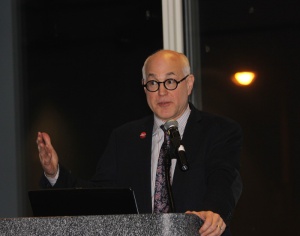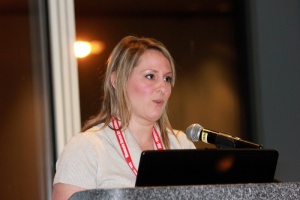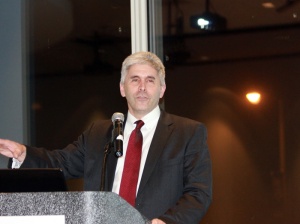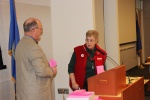Advocates Press For Uninsured To Get Special Enrollment Option After They See Tax Penalties
Sunday’s deadline for signing up for health insurance on the exchanges will have long passed by the time many people file their taxes this March and April. But that may be the first time it sinks in for some people that they owe a penalty for not having insurance last year. Consumer advocates want the government to give them a chance to sign up for 2015 coverage after the enrollment deadline.
But federal officials say they’re not making any promises.
“There’s still a lack of awareness about the requirement to have insurance and opportunities for people to get subsidies to make it more affordable,” says Rachel Klein, director of organizational strategy at Families USA, a consumer advocacy group.
Families USA and other consumer groups are urging the government to create a special enrollment period of up to 60 days for uninsured people who file their taxes after open enrollment ends on Sunday.
“This is a great teachable moment,” Klein says. Last year, Families USA advocated aligning the tax filing deadline with the open enrollment deadline.
Uninsured consumers who miss Sunday’s deadline could be on the hook not only for 2014 taxes, but also for 2015.
Generally, unless people experience a life event such as marriage or loss of on-the-job coverage they can’t buy insurance on the exchanges beyond the annual enrollment period.
Meanwhile, the penalty for not having coverage is getting steeper. For 2014, it’s $95 per adult or 1 percent of annual income, whichever is greater. In 2015, the financial consequences increase to the greater of $325 per person or 2 percent of annual income.
Although administration officials have been quoted in some news accounts saying they might consider a special enrollment period for people who file taxes after Feb. 15, it’s not a done deal by any means.
In a conference call to discuss enrollment progress on the federal exchange earlier this week, Andrew Slavitt, principal deputy administrator at the Centers for Medicare & Medicaid Services, said, “Consumers should consider February 15 as their last opportunity to get coverage, and we won’t be considering anything until we get through this open enrollment period.”
Please contact Kaiser Health News to send comments or ideas for future topics for the Insuring Your Health column.
Kaiser Health News (KHN) is a national health policy news service. It is an editorially independent program of the Henry J. Kaiser Family Foundation.
The Same Fight
The same fight
Nurses support the United Steelworkers on their strike lines
Members of the United Steelworkers union on strike from their jobs at the Tesoro Golden Eagle Refinery in Martinez, Calif. got a major boost today from registered nurses around the Bay Area who joined their picket line to show support and share stories about why it’s critical for workers to have a say in their work in order to protect the health and safety of themselves and their communities.
“Nurses are here today because so many of the conditions the steelworkers are facing are the same the nurses are facing,” said Katy Roemer, an RN at Kaiser Permanente Oakland Medical Center. “They need the ability to shut down production when they identify health and safety risks.”
The refinery workers reported that they are often forced to work mandatory overtime; required to work consecutive days for weeks without a day off; constantly asked to speed up the throughput of the refinery while at the same time pushed to cut corners; and ignored by management when they put in requests for equipment to be repaired or maintained.

Nope! Steelworkers and Nurses turn back oil trucks.
When the refinery has accidents and gas flares, toxic substances and particulates are often released into the air. Pamela Luiz, an RN who works in the emergency room at Kaiser Antioch and also lives in Antioch, has resided downwind of the Golden Eagle refinery for 20 years. She said that asthmas rates in her community are alarming and every time there’s a refinery release, the nurses observe many more people flooding the ER. She’s constantly worried for her granddaughter, who lives with her and suffers from asthma.
“Before, you’d see more asthma cases with the spring and fall weather changes,” said Luiz. “Now it’s gotten to the point where it’s year round.”
Steelworker Rafael Zabat works on the “alki unit,” a nickname for the “alkylation plant,” where workers operate sophisticated equipment that takes waste gases from the refining process and, using sulphuric acid as a catalyst, converts them into a liquid that is used to blend high-octane gasoline. It’s a complicated process that requires many different chemicals and materials to be held in balance and strict attention to various pressures, levels, and temperatures in order to run within safe parameters.

Rafael Zabat says his company was reluctant to maintain equipment because of lost productivity.
Zabat and his coworkers said that, for years, company has been pushing the operators who control the “board” (kind of the master dashboard of all the equipment readings) to run much higher rates of throughput than the operators believed the system could handle. Sulphuric acid is also expensive, so at the same time, the company had been pushing workers to cut the amount of acid that they were using. Both practices are much harder and more corrosive on the equipment, and workers had over the years submitted multiple requests to management for the pipes to be fixed, cleaned, and maintained. But the company, reluctant to shut down the unit because any stoppage means loss of profits, either fixed equipment very slowly or not at all.
On Feb. 12, 2014, Zabat and another alki operator were putting a piece of equipment into service and checking how much sulphuric acid was still in the system. As they opened a valve, a pipe ruptured about five feet from where they were standing and sprayed both of their entire bodies with sulphuric acid. They immediately rushed to a safety shower and rinsed off as much as they could. They had been wearing personal protective equipment, but the outfit was designed more for flash fires, not chemical spills. “My face was burning,” remembered Zabat. “It got in my mouth, on my lips, face, ears, neck.”

Carson Steelworkers and Nurses picket Tesoro
The two were airlifted by helicopter to UC Davis Medical Center, where they were told they were lucky to have escaped with second-degree chemical burns. All the skin on Zabat’s face bubbled and blistered up; he had scars for another six to eight months. He spent six months off work recuperating, during which the company dismissed his burns as “minor injuries” and pushed him to return to work earlier than he was ready. At one point during his recovery, before various providers had his workers compensation policy number, he received a $42,000 bill for the airlift from the helicopter company. His family was traumatized by the entire incident, and he himself had to go through some counseling before he could go back to his position.
Zabat still works on the alki unit; he would be reluctant to transfer to another area because he is as close to his coworkers as family. He said that the company appeared to shape up after he was burned, but now has fallen into their old habits of deferring maintenance. “It would be nice to see them have a proactive approach to safety instead of a reactive approach,” said Zabat. “So this strike is for the safety of the workers and the communities around us.” — Lucia Hwang
Government To Grade Nursing Homes On Tougher Scale
Starting immediately, the federal government is making it harder for nursing homes to get top grades on a public report card, in part by increasing scrutiny of their use of anti-psychotic drugs and raising the bar on an array of quality measures.
Those grades – in the form of one- to five-star ratings – are part of Nursing Home Compare, a government website to help consumers evaluate nursing homes. While the star ratings, which debuted in December 2008, are lauded as an important tool, critics say they rely too heavily on self-reported data and allow a majority of homes to score high ratings.
The website rates more than 15,000 nursing homes in three broad categories: government inspections, quality measures and staffing levels. An overall score is a fourth category.
The system has come under recent criticism with complaints that some highly rated nursing homes have numerous problems and face fines and other enforcement actions. On Thursday, the federal government said it would require nursing homes to do more to get higher quality scores.
Among the better-known measures that go into quality scores are the percentages of residents who develop bed sores or are injured in falls. The scores will now count the percentage of residents given anti-psychotic drugs, reflecting concern that too many are unnecessarily drugged to make them easier to manage. All of those measures will continue to be reported by the homes themselves, however.
The changes mean many homes could drop a star or more from their January levels, even though nothing may have changed, said officials from the Center for Medicare & Medicaid Services. They declined to say how many might see a ratings drop.
Consumer advocates welcomed the adjustments, but industry officials said the new rules may confuse patients and their families if scores change suddenly.
“If centers across the country start losing star ratings overnight, it sends a signal to families and residents that quality is on the decline, ” said Mark Parkinson, president and CEO of the American Health Care Association, the industry lobby.
But Brian Lee with Families for Better Care, a Florida-based advocacy group for nursing home residents and their families, said the shift was necessary. More information is always better, he said. He and other advocates had raised concerns that high rates were too easy to achieve.
Lee said about 55 percent of the nation’s nursing homes had overall scores of either four or five stars on Nursing Home Compare in January. Drilling down, Lee said only about one-third of them got four or five stars on the website for inspections, which he calls the most objective measure because it is based on government, rather than self-reported data. “But when you look at the quality scores portion, 80 percent of homes are four- or five-star rated,” Lee said. “Something is not coming out in the wash.”
The new ratings will be reflected on the website as of Feb. 20. Nursing home administrators will be able to see their scores under the new system starting Friday.
The changes follow others announced in October that require additional verification of self-reported staffing levels and other efforts to confirm quality data submitted by the homes.
Kaiser Health News (KHN) is a national health policy news service. It is an editorially independent program of the Henry J. Kaiser Family Foundation.
Video: MNA Nurses Support Effort to End Workplace Violence
Study: Physicians Report Few Requests By Patients For ‘Unnecessary’ Treatments
Though medically unnecessary tests and procedures are often blamed for the nation’s high health care costs, patients’ requests for such superfluous treatments may not be what triggers them, suggests a study published today in the JAMA Oncology.
Conventional wisdom suggests that doctors often give unnecessary treatments because patients demand them. Some estimate this care account for a third of the $2.8 trillion spent annually.
But the survey, which tracked 60 Philadelphia-based clinicians’ interactions with about 3,600 cancer patients, found that patients asked for a particular treatment in only 8.7 percent of those exchanges. Of those requests, doctors considered only 11.4 percent to be for inappropriate or unnecessary care.
Those findings, the paper’s authors write, indicate that patient demands are likely not the impetus for unnecessary procedures. That might suggest doctors provide extraneous treatments for other reasons, though the authors didn’t speculate on what those could be.
“There just aren’t many patients’ demands or requests for unnecessary tests and treatments, and when there are, doctors comply with very few of them,” said Ezekiel Emanuel, one of the authors and chair of the University of Pennsylvania’s Department of Medical Ethics and Health Policy.
It’s not entirely clear whether the findings from this study, which focused on oncologists and cancer patients, can be generalized to medicine at large. Though cancer seems like a fitting condition to study due to its “extremely high stakes and very expensive treatments,” it is possible other specialties, such as primary care, actually elicit a lot more patient-requested procedures, said Emanuel, who also is a former White House health policy adviser.
He recommended other researchers conduct similar studies investigating other specialties in cities other than Philadelphia to see whether those results echo this study’s conclusions. When it comes to patient requests, “if you don’t see them in oncology, it’s kind of unlikely you’re going to see them a lot of other places, like cardiology or rheumatology or surgery,” he added.
The authors may be correct that patients in general don’t seek unnecessary treatment, said Jason Doctor, an associate professor at the University of Southern California’s School of Pharmacy, who was not involved in the study. “But they need to test it in a broader, more general clinical setting,” such as outpatient facilities, he said.
It would make sense to expect similar results in other specialties, said Katherine Kahn, a professor of medicine at the University of California at Los Angeles and a senior scientist at the RAND Corp., which researches health costs, among other subjects. Still, Kahn, who is not affiliated with the study, cautioned against using the results to make a definitive statement about what drives health costs.
The study indicates that patient requests can be a valuable part of practicing medicine, she said, highlighting needs doctors otherwise might not notice. “Patients often have information about their symptoms or their values or their priorities that clinicians might not know,” Kahn said.
But it takes a bit of a jump, she added, to go from establishing that idea to answering questions around “overuse and costs associated with overuse in the United States.”
That’s especially true in this study, she said, because doctors were the ones who determined and reported what wasn’t an appropriate request – and that potential bias or perspective makes it hard to know how often wasteful or unnecessary procedures actually took place.
Even so, Emanuel said, it still highlights a larger point.
Anecdotally, “It’s doctors who say, ‘we had a lot of patients ask for inappropriate tests and treatments.” By quantifying how often doctors actually think this happens – and by noting that, in practice, doctors rarely indicate this is the case – the findings suggests patient demands aren’t the source of wasteful procedures, he said.
“There’s always this question about provision of inappropriate treatment: Is it driven by patient demand or provider supply, and what’s the best way to address the problem?” Doctor said. “People should study this through – then we can understand whether we should do supply-side intervention or demand-side interventions to reduce inappropriate treatment.”
Kaiser Health News (KHN) is a national health policy news service. It is an editorially independent program of the Henry J. Kaiser Family Foundation.
Nurses bring ‘passionate commitment’ to 2015 Day on the Hill
Inspiring, empowering, and energizing. Those are some of the words MNA members used to describe Day on the Hill 2015.
About 150 RNs from throughout Minnesota stood up for their patients, their profession, and their communities at the February 9-10 event in St. Paul.
Members sat down with their legislators to share their experiences as bedside RNs to show why a Safe Patient Standard and workplace violence prevention legislation are needed. They told their personal stories of instances where patient safety was threatened because of understaffing; and times when they were subjected to workplace violence themselves.
They crowded into a room at the Minnesota Department of Health to deliver more than 2,000 ‘valentines’ – Concern for Safe Staffing Forms filed in 2014, documenting situations where patients were at risk due to low staffing levels.
Dozens of RNs lined up to share their stories at an emotional meeting with Health Commissioner Ed Ehlinger.
Some teared up telling their stories and as they identified with other nurses’ concerns.
“We are bringing these valentines from nurses on day shift, night shift, holiday shift, weekends, holidays,” said MNA President Linda Hamilton. “Here’s proof that we need more nurses. We want to do what’s best for our patients.”
Nurses document unsafe staffing in their hospitals by filling out Concern for Safe Staffing Forms and sharing them with their supervisors and the Minnesota Nurses Association.
“The hospitals aren’t giving you the information you need, so we will,” said oncology nurse Theresa Peterson, RN at North Memorial Hospital. “When (cancer) patients need medications, it’s an hourly thing. So if you have five other patients, they don’t get seen.”
Commissioner Ehlinger promised that he and his staff would read the forms and use them to inform their policy discussions.
Other highlights of Day on the Hill:
- National Nurses United Public Policy Director Michael Lighty brought the national perspective in his remarks during the February 9 kickoff. He urged MNA members to use their
 “passionate commitment” for their patients when advocating for change at the state and national levels to “transform our country.”
“passionate commitment” for their patients when advocating for change at the state and national levels to “transform our country.” - St. John’s Hospital nurse Amy Schmidt spoke publicly for the first time about the patient attack on nurses on her unit last November. She described how the attack unfolded and how it changed the lives of everyone involved.
 Schmidt said every hospital should have a plan to deal with crises. “I urge all nurses to get involved and stop thinking that workplace violence is part of our jobs. It is not.”
Schmidt said every hospital should have a plan to deal with crises. “I urge all nurses to get involved and stop thinking that workplace violence is part of our jobs. It is not.” - Rep. Joe Atkins told members their voices do make a difference. “There’s not a legislator who doesn’t respect what you do. You have a case to make.”
He promised to fight for safe patient staffing and workplace violence prevention legislation.
staffing and workplace violence prevention legislation.
Great Media Coverage: North County Coalition Lays on Reasoning for Full-Service Hospital
Here is a great media story about the press conference last night by the North County Cares Coalition, where MNA presented findings of a new report showing a fu…
Legislative Day 2015
Save the date for PSNA’s annual Legislative Day in Harrisburg. This year, we’ll be meeting on April 20, 2015 for a day of education, advocacy and networking. Stay tuned for details and registration!
Concierge Medicine Firm Found Liable For Doctor’s Negligence
WEST PALM BEACH, Fla. — MDVIP, the nation’s largest concierge medicine practice, has seen meteoric growth since it was founded fifteen years ago promising “exceptional care” and quick access to doctors in exchange for a $1,500 annual membership fee.
But it took a big hit Tuesday when a Palm Beach County, Fla. jury returned an $8.5 million malpractice verdict against the company, which has nearly 800 affiliated physicians in 41 states. It was the first malpractice verdict against MDVIP, and is believed to be the first against any concierge management firm. The companies offer such perks as same-day appointments and more personalized care with contracted doctors in return for a retainer.
The jury found MDVIP was liable for the negligence of one of its physicians, who was sued for misdiagnosing the cause of a patient’s leg pain, leading to its amputation. The jury also found the firm had falsely advertised its exceptional doctors and patient care.
Industry experts say the ruling is significant because it shows concierge companies can be held liable for the care provided by their contracted doctors. The companies typically argue they do not actually provide care but merely act as brokers between doctors and patients.
“This pierces that veil…and shows these companies have a legal risk that everyone assumed did not exist,” said Tom Blue, chief strategy officer of the American Academy of Private Physicians, a trade group of concierge doctors.
MDVIP argued it was not responsible for the actions of a physician with whom it had contracted. MDVIP physicians are not directly employed by the company; the physicians pay the firm a per-patient fee for services such as marketing, branding, and other support.
The doctor, Charles Metzger Jr., settled with the plaintiff’s family before the trial.
MDVIP representatives declined to be interviewed, but they indicated they would appeal the verdict. In a statement, the company said it and Metzger acted appropriately.
Karen Terry, one of the plaintiff’s attorneys, said the verdict will push MDVIP and similar companies to scrutinize doctors more carefully before they affiliate with them because they may be liable for the doctors’ actions.
Such companies will also be more cautious about advertising that they offer better care. “You can’t make promises you can’t keep,” Terry said. “This verdict is going to have a huge impact on MDVIP.”
Harry Nelson, a Los Angeles health care attorney, agreed the verdict will change how companies market their doctors. “A lot of people will be taking notice of this verdict…It’s a shocking decision,” he said. “The result of this decision is going to be more caution from the concierge medicine companies in terms of their claims of providing superior care.”
But Roberta Greenspan, founder of Specialdocs Consultants, a concierge medicine consulting firm in Chicago, was skeptical of the decision’s significance.
“This singular verdict will not have a major long-term effect on the industry,” she said. “The industry has evolved from a fad years ago to one that has gained tremendous respect.”
An estimated 6,000 doctors nationally have moved to concierge-style practices in the past 15 years, with the figure doubling just in the past five, according to the concierge trade group. Patients who see concierge doctors typically pay an annual fee, in addition to their insurance coverage, in return for gaining easier access to doctors and more personalized care.
The lawsuit against MDVIP was brought by the widower of the late Joan Beber of Boca Raton, who had sought medical attention for leg pain. Despite what plaintiff’s lawyers described as the progressive worsening of her condition, she was repeatedly misdiagnosed by Metzger and other MDVIP-affiliated staff. She was referred to orthopedists who they contended did not get her medical records or learn of her worsening symptoms. The information, they argued, might have led to the discovery of a serious circulation problem that eventually required above-the-knee amputation of her leg.
Beber died of leukemia four years after her leg was amputated in 2008.
Dr. Matthew Priddy, president of the concierge trade group, said the verdict will “give national companies pause if they are on the hook” for their physicians’ care.
Still, Priddy said the industry’s track record is good. While concierge physicians are not immune from malpractice suits, they are less likely to face them because they spend more time with patients than most doctors, he said. They typically limit their patients to a few hundred a year – 600 is the limit for MDVIP doctors — compared to a few thousand for an average practice. They are able to do that because the retainer fees make up for lost revenue.
Kaiser Health News (KHN) is a national health policy news service. It is an editorially independent program of the Henry J. Kaiser Family Foundation.










